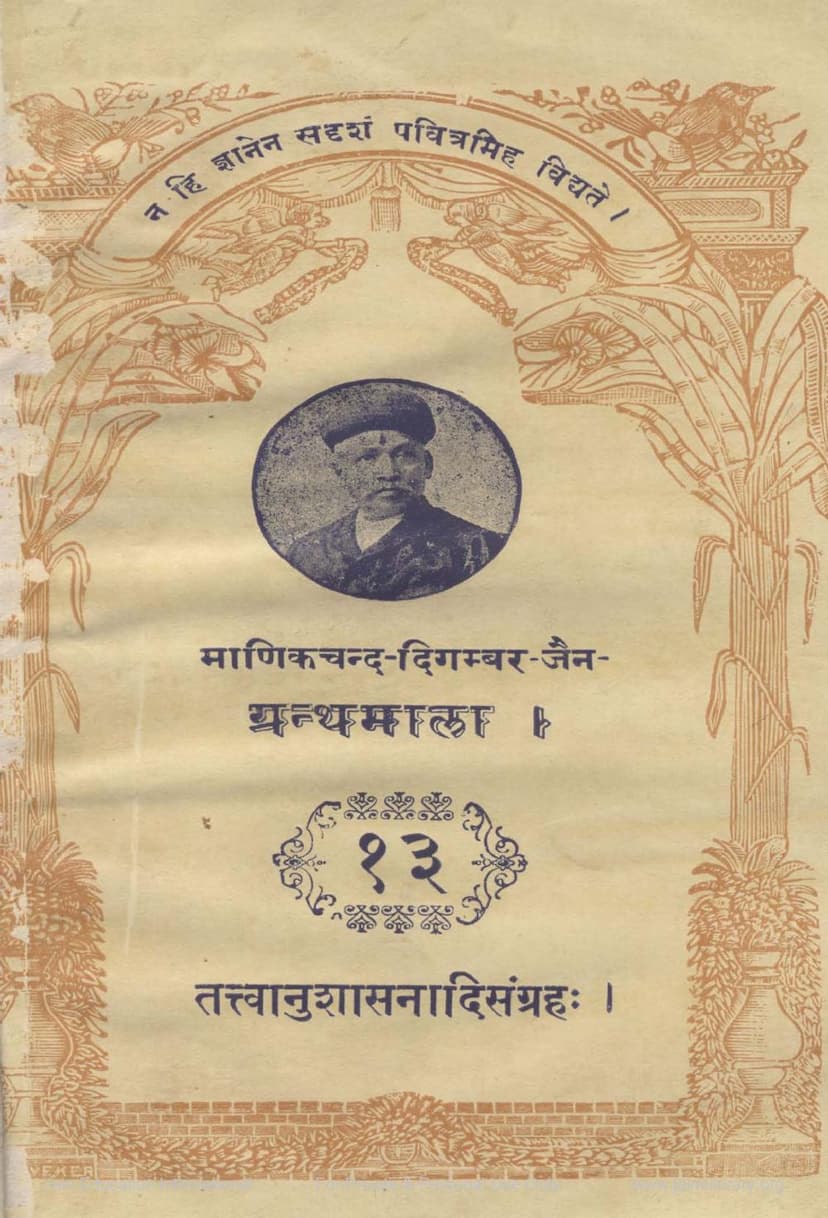Tattvanushasanadi Sangraha
Added to library: September 2, 2025

Summary
This is a comprehensive summary of the Jain text "Tattvanushasanadi Sangraha," compiled by Pandit Manoharlal Shastri and published by the Manikchand Digambar Jain Granthamala Samiti. The text is a collection of fourteen important Jain works, including philosophical treatises, ethical codes, and devotional hymns.
Overview:
The "Tattvanushasanadi Sangraha" is a significant compilation of Jain literature, presented as the thirteenth work published by the Manikchand Digambar Jain Granthamala. The collection aims to preserve and disseminate valuable Jain scriptures, making them accessible to a wider audience. The publication is dedicated to the memory of the late Seth Manikchandji, a philanthropist and patron of Jain literature.
Contents and Authors:
The Sangraha includes the following fourteen works:
- Tattvanushasan (तत्त्वानुशासन) by Acharya Nagasen.
- Ishtopadesha (इष्टोपदेश) with a commentary by Acharya Pujyapada (Devanandi).
- Nitisara (नीतिसार) by Indra Nandisurī.
- Mokshapañcasika (मोक्षपंचाशिका) by an unknown author.
- Shrutavatara (श्रुतावतार) by Indra Nandisurī.
- Adhyatmataraṅgiṇī (अध्यात्मतरंगिणी) with commentary by Somadeva.
- Pātrkesari Stotra (पात्रकेसरिस्तोत्र) attributed to Acharya Pātrkesari (Vidyānandi).
- Adhyāṣṭaka (अध्यात्माष्टक) by Vādirāja Sūri.
- Dvātrinśatikā (द्वात्रिंशतिका) by Amitagati Sūri.
- Vairāgyamaṇimālā (वैराग्यमणिमाला) by Shrichandra, disciple of Shrutasagar Sūri.
- Tattvasāra (तत्त्वसार) (Prakrit) by Devasena Sūri.
- Shrutaskandha (श्रुतस्कन्ध) (Prakrit) by Brahmachari Hemachandra.
- Dhāḍhasī Gāthā (ढाढसी गाथा) by a Kāṣṭhāsaṅgha Acharya.
- Jñānasāra (ज्ञानसार) by Padmasimha Muni.
Key Features and Information:
- Compilation Purpose: The collection aims to revive and promote the study of these important Jain texts, which are considered essential for understanding Jain philosophy, ethics, and spiritual practices.
- Authorship and Chronology: The preface provides brief introductions to the authors and their respective works, including estimated time periods of their compositions. For instance, Acharya Nagasen, author of Tattvanushasan, is believed to have lived before the 13th century Vikram Samvat. Acharya Pujyapada (Devanandi), author of Ishtopadesha, is placed in the 6th century Vikram Samvat. Pandit Ashadhar, the commentator on Ishtopadesha, is identified as a scholar of the 13th century Vikram Samvat.
- Manuscript Sources: The preface mentions that the texts were sourced from old manuscripts, often from private collections or temple libraries, highlighting the effort made to obtain accurate versions for publication. For example, Tattvanushasan was based on a single, very old manuscript.
- Commitment to Jain Heritage: The Manikchand Digambar Jain Granthamala Samiti is dedicated to the preservation of Jain literature, selling these books at cost price to make them widely accessible. The publication encourages support from all religious individuals for this noble cause.
- Content Focus: The collection covers various aspects of Jainism:
- Philosophy: Texts like Tattvanushasan, Tattvasara, and Mokshapañcasika delve into the fundamental principles of Jainism, including the nature of reality, soul, karma, liberation, and the path to spiritual realization.
- Ethics and Conduct: Nitisara and Shruta Avatara provide guidance on ethical conduct and the proper understanding of Jain scriptures. The preface to Nitisara discusses the distinctions between various Jain monastic orders and the importance of adherence to scriptural principles.
- Devotional Practices: Pātrkesari Stotra, Adhyāṣṭaka, and Vairāgyamaṇimālā offer devotional hymns and reflections on detachment and spiritual yearning. Pātrkesari Stotra is highlighted as a profound philosophical work in the form of a hymn.
- Spiritual Practices: Adhyātmataraṅgiṇī and Jñānasāra focus on spiritual practices, meditation, and the path to self-realization. The summary of Adhyātmataraṅgiṇī mentions its focus on meditation and the path to liberation, while Jñānasāra emphasizes the importance of knowledge and self-reflection.
- Commentaries: Several works include commentaries, such as the Vritti on Ishtopadesha by Pandit Ashadhar, and the commentary on Adhyātmataraṅgiṇī.
- Language: The collection includes works in Sanskrit and Prakrit.
Significance:
The "Tattvanushasanadi Sangraha" is a valuable resource for scholars, practitioners, and anyone interested in delving deeper into the rich philosophical and spiritual heritage of Jainism. It represents a significant effort to preserve and make accessible a collection of diverse yet interconnected Jain texts that illuminate the path to liberation.